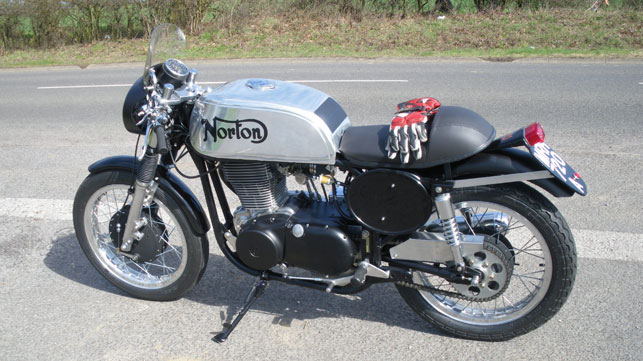Although semi-retired, motorcycle engineer Martyn Roberts still dabbles in motorcycle engineering as a hobby having recently built a replica Manx Norton. Here he looks back on the UK industry trends from the 1980s
My career as a motorcycle engineer started by accident really, perpetuated by a love of motorcycles rather than any specific training.

Martyn Roberts’ replica of the Manx Norton
I had actually studied mechanical engineering at Leeds University before undergoing a five year apprenticeship at BAE Systems (then British Aerospace).
In 1981 I applied for a job at Triumph Motorcycles, which at that time was based in Meriden, near Solihull, following the bombing of the original Coventry factory during World War Two, and run by a worker’s co-operative.
Although I didn’t have a motorcycle track record I managed to persuade the interviewers that I was passionately keen about motorbikes and they employed me as the chief development engineer.
One of the most interesting projects I had during my time at Meriden was for a police force that claimed its motorcycles weren’t stable at high speeds.
We actually took the bike into British Aerospace’s wind tunnel at Hatfield, possibly the first time that a Triumph had ever been into a wind tunnel. It was quite an adventure and successful too as we subsequently produced a more stable, low lift fairing model for the police force.
However, time was running out for the co-operative and in 1983 it folded. In the year following its collapse, and before I returned to Triumph, I lectured at the University of Central England (now Birmingham City University). Whilst there I was one of the first people to use finite element (FE) computing for motorcycle frames.
In those days, to produce even a simple model of a motorcycle frame, the computer had to run overnight on a batch basis as you couldn’t have it tied up during the working day.
Finite element computing provided an insight into the stresses and deflections of bike frames, which was impossible to do previously
It was also operated by punch cards, which some DEVELOP3D readers may remember. You would have to type individual lines of code for the data using a special typewriter, which would generate a series of punched cards about the size of airline tickets, presumably representing the binary code.
This stack of cards would then be taken across to the computer and loaded into a reader. This had to be done very carefully as you’d be in big trouble if you dropped any as they were all in sequence.
That kind of analysis provided an insight into the stresses and deflections of motorcycle frames, which was impossible to do previously.
The new Triumphs, which were launched at the end of the 1980s, were amongst the first motorcycles anywhere to benefit from that kind of technology. At that time I was back working at Triumph, as a new owner had bought the manufacturing rights and had set up a factory in Hinckley, near Coventry. Whilst there, 1984 to 1989, I worked on the modular range launched in 1990.
Although I can’t specifically talk about the work I did at Triumph under the conditions of my severance, I will relate some of the general industry trends.
Perhaps the most noticeable was the disappearance in large part of the UK supply chain, a lot of which was based in the hub of the Midlands.
I guess two things hastened that disappearance – the closing of the Triumph company at Meriden in 1983 and just ahead of that that there had been the Hesketh motorcycle project, which took a lot of the smaller businesses down with it when it folded in the early 1980s.
With the UK motorcycle component industry pretty much finished off it became necessary to look abroad for crucial parts. Japan was an obvious choice as the parts were high quality and very price competitive.
I guess the other thing that really took off in the 1980s was the introduction of automation.
The greater use of computers took out a lot of human input in the factory. Whereas previously a team of 30 would manually produce all the major parts of the engine, this was now done in a machine tool cell with only three or four people overseeing the operation.
The benefits were that it allowed the factory to achieve very repeatable results with little fuss over long production runs.
It also led to an almost self enforcing quality from the motorcycle designers and engineers.
Take frame welding for instance. Previously a manual welder would fill in any slight gaps in the joint between the frame tubes with weld but a robot can’t do that.
So in order to design for robot welding, you had to make everything super accurate and that kind of rigour went right through the design.
Of course during the 1980s the motorcycles themselves were also undergoing a change. Before then it was still quite common to buy a base model motorcycle that the owner could turn into four or five different kinds of bike.
For instance, a base model could become a touring bike with the addition of a large fairing and luggage, or a cruiser with different seat, handlebars and tyre sizes.
But that pattern started to disappear as the motorcycles themselves were styled to suit specific market sectors.
Having left Triumph in 1989 I briefly went to the Birmingham Small Arms Company where I worked on a project to produce a bespoke enthusiasts’ motorcycle around a Harley Davidson engine.
I left there in 1991 and although I then migrated across to the car industry I have always been an avid motorcycle fan and have dabbled in motorcycle engineering as a hobby.
Most recently I’ve built my own motorcycle from scratch – it’s a homage to the famous 1950’s Manx Norton, a very stylish bike that is quite thrilling to ride.
It was the first time I had designed a motorcycle since leaving the industry and my biggest problem was not having access to a fully equipped machine shop, which meant I had to design around available parts wherever possible and keep alterations to a minimum.
Starting from a 1959 Norton featherbed frame, I used a 1986 Suzuki 650 engine, various Norton racing parts and components from other motorcycles. The end result weighs just 158kg and took 14 months to build in my garage.
It’s the sort of thing that keeps semi-retired motorcycle engineers like myself out of mischief.
The changing face of motorcycle manufacturing through the decades
Default






